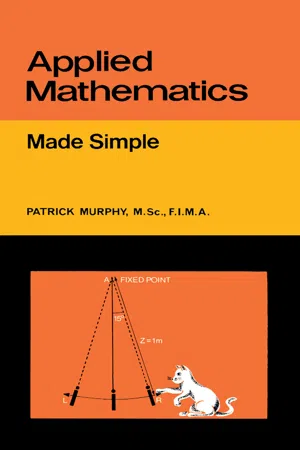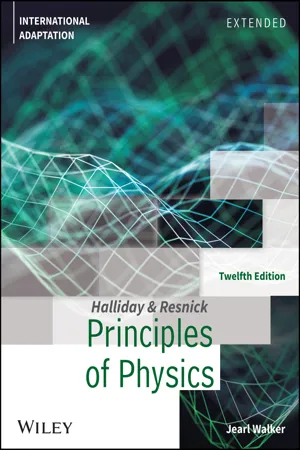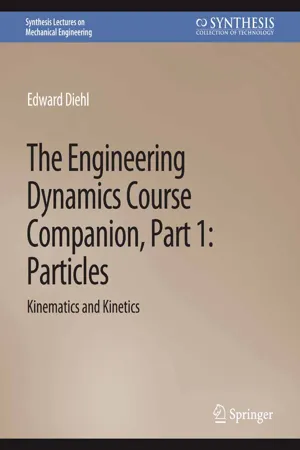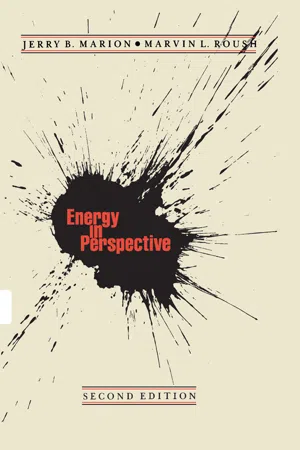Physics
Work and Energy
Work and energy are fundamental concepts in physics. Work is the transfer of energy that occurs when a force is applied to an object and it moves in the direction of the force. Energy is the ability to do work and is classified into different forms such as kinetic, potential, and thermal energy. These concepts are essential for understanding the behavior of physical systems.
Written by Perlego with AI-assistance
Related key terms
1 of 5
10 Key excerpts on "Work and Energy"
- eBook - PDF
- Richard C. Hill, Kirstie Plantenberg(Authors)
- 2013(Publication Date)
- SDC Publications(Publisher)
One definition of work is “The amount of energy transferred by a force acting through a distance.” What does that mean in the context of dynamics? If a force is applied to a particle and the force causes that particle to move through a distance, the force has done work. This also means that the force has transferred some energy to (or from) the particle. Energy is the capacity of a particle to do work, which makes sense. If you put energy into a particle, then that particle now has the ability to do work. A particle can possess different forms of energy. The two forms related to dynamics that we will be discussing are the energy of motion (kinetic energy) and the energy of position (potential energy). So what is the difference between Work and Energy? Work and Energy possess the same units (Joules) and they are related in that work is the process of a force transferring energy, while energy is a measure of the ability of a system to do work. Work doesn’t always have to add energy to a system, it can also take energy from a system. Consider that you are driving a car down the road at 70 mph. The car has the energy of its motion (kinetic energy). A deer crosses your path and you slam on the brakes causing you to skid. The friction force that develops between your tires and the road slows your car to an eventual stop. The friction force is applied over a distance (the stopping distance), therefore, it does work. The work done takes energy out of the car, which means that the work is negative. Now that we have a physical understanding of what work is, let’s go back and look at Equation 7.1-1 and attempt to gain a mathematical understanding of the work equation. Equation 7.1-1 states that the work U done by an external force F being applied to the particle is equal to the integral of the dot product of F with the differential change in position dr. - eBook - PDF
Applied Mathematics
Made Simple
- Patrick Murphy(Author)
- 2014(Publication Date)
- Butterworth-Heinemann(Publisher)
Work, Energy, and Power 217 CHAPTER TWELVE WORK, E N E R G Y A N D P O W E R (1) Work In applied mathematics, work is associated with the movement of bodies from one position to another. Since the movement of a body from rest re-quires force, and the change in position is represented by displacement, we shall define work by relating it to force and displacement. If you help to push-start a car with a flat battery on a winter's morning you will readily agree on three things : pushing the car 20 m will be only half the 'work' of pushing it 40 m ; directing your push in the line of motion is better than pushing in any other direction ; finally, the sooner you can find a down-ward slope the better. If a young child helps you push she will not do the same amount of work as you, even though she will move just as far. The differ-ence between your work contribution and hers will have something to do with the magnitude of the force applied to the car. We therefore conclude that a definition of work involving force and distance looks promising. In order to keep the early ideas as simple as possible we shall consider first, the work done by a force acting on a particle. DEFINITION : / / a constant force of magnitude Fis applied to a particle which then moves a distance s along the line of action of F, the product Fs is called work and is said to be a measure of the work done by the force on the particle. To measure anything we must have a standard unit. The search for a unit need only be brief because we have already obtained units for F and s. Since the standard units are newtons for F and metres for s, it follows that Fs must be measured in newton metres. Unfortunately this is the same measurement as for moment of a force, so it would be helpful to have some means of distinguishing between the two. We therefore refer to the newton metre, when it is a unit of work, as a joule (pronounced 'jewel'). - David Halliday, Robert Resnick, Jearl Walker(Authors)
- 2023(Publication Date)
- Wiley(Publisher)
3. Only the component of F → that is along the displacement d → can do work on the object. 4. When two or more forces act on an object, their net work is the sum of the individual works done by the forces, which is also equal to the work that would be done on the object by the net force F → net of those forces. 5. For a particle, a change ΔK in the kinetic energy equals the net work W done on the particle: ΔK = K f − K i = W (work–kinetic energy theorem), in which K i is the initial kinetic energy of the particle and K f is the kinetic energy after the work is done. The equation rearranged gives us K f = K i + W. LEARNING OBJECTIVES 7.2 Work and Kinetic Energy 149 Work If you accelerate an object to a greater speed by applying a force to the object, you increase the kinetic energy K (= 1 _ 2 mv 2 ) of the object. Similarly, if you decelerate the object to a lesser speed by applying a force, you decrease the kinetic energy of the object. We account for these changes in kinetic energy by saying that your force has transferred energy to the object from yourself or from the object to yourself. In such a transfer of energy via a force, work W is said to be done on the object by the force. More formally, we define work as follows: Work W is energy transferred to or from an object by means of a force acting on the object. Energy transferred to the object is positive work, and energy trans- ferred from the object is negative work. “Work,” then, is transferred energy; “doing work” is the act of transferring the energy. Work has the same units as energy and is a scalar quantity. The term transfer can be misleading. It does not mean that anything material flows into or out of the object; that is, the transfer is not like a flow of water. Rather, it is like the electronic transfer of money between two bank accounts: The number in one account goes up while the number in the other account goes down, with nothing material passing between the two accounts.- eBook - PDF
- John D. Cutnell, Kenneth W. Johnson, David Young, Shane Stadler(Authors)
- 2021(Publication Date)
- Wiley(Publisher)
Kinetic energy, like work, is a scalar quantity. These are not surprising observations, because work and kinetic energy are closely related, as is clear from the following statement of the work–energy theorem. THEWORK– ENERGYTHEOREM WhenanetexternalforcedoesworkWonanobject,thekineticenergyofthe objectchangesfromitsinitialvalueofKE 0 toafinalvalueofKE f ,thedifference betweenthetwovaluesbeingequaltothework: W= KE f − KE 0 = 1 _ 2 m υ f 2 − 1 _ 2 m υ 0 2 (6.3) Work done by net ext. force *For extra emphasis, the final speed is now represented by the symbol υ f , rather than υ. INTERACTIVE FIGURE 6.5 A constant net external force Σ → Facts over a displacement → s and does work on the plane. As a result of the work done, the plane’s kinetic energy changes. s v 0 v f Final kinetic energy = m f 2 _ 1 2 1 2 Initial kinetic energy = m 0 2 _ ΣF ΣF υ υ 6.2 The Work–Energy Theorem and Kinetic Energy 163 The work–energy theorem may be derived for any direction of the force relative to the displacement, not just the situation in InteractiveFigure6.5. In fact, the force may even vary from point to point along a path that is curved rather than straight, and the theorem remains valid. According to the work–energy theorem, a moving object has kinetic energy, because work was done to accelerate the object from rest to a speed υ f . † Conversely, an object with kinetic energy can perform work, if it is allowed to push or pull on another object. Example 4 illustrates the work–energy theorem and considers a single force that does work to change the kinetic energy of a space probe. Description Symbol Value Comment ExplicitData Mass m 474 kg Initial speed υ 0 275 m/s Magnitude of force F 5.60 × 10 −2 N Magnitude of displacement s 2.42 × 10 9 m ImplicitData Angle between force → Fand displacement → s θ 0° The force is parallel to the displacement. - eBook - PDF
- Robert Resnick, David Halliday, Kenneth S. Krane(Authors)
- 2016(Publication Date)
- Wiley(Publisher)
F B CHAPTER 11 CHAPTER 11 ENERGY 1: WORK AND KINETIC ENERGY W e have seen how Newton’s laws are useful in un- derstanding and analyzing a wide variety of problems in mechanics. In this and the following two chapters we consider a different approach based on one of the truly fundamental and universal concepts in physics: energy. There are many kinds of energy. In this chapter we consider one particular form — kinetic energy, the energy associated with a body because of its motion. We also introduce the concept of work, which is re- lated to kinetic energy through the work – energy theorem. This theorem, derived from Newton’s laws, pro- vides new and different insight into the behavior of mechanical systems. In Chapter 12 we introduce a sec- ond kind of energy — potential energy — and begin developing a conservation law for energy. In Chapter 13 we discuss energy in a more comprehensive way and generalize the law of conservation of energy, which is one of the most useful laws of physics. application moves through some distance, and one way to define the energy of a system is a measure of its capacity to do work. In the case of the wheelchair rider, he does work because he exerts a force as the wheelchair moves forward through some distance. For him to do work, he must ex- pend some of his supply of energy — that is, the chemical energy stored in his muscle fibers — which can be replen- ished from his body’s store of energy through resting and which ultimately comes from the food he eats. The energy stored in a system may take many forms: for example, chemical, electrical, gravitational, or mechanical. In this chapter we study the relationship between work and one particular type of energy — the energy of motion of a body, which we call kinetic energy. 11- 2 WORK DONE BY A CONSTANT FORCE Figure 11-2a shows a block of mass m being lifted through a vertical distance h by a winch that is turned by a motor. - eBook - PDF
- John D. Cutnell, Kenneth W. Johnson, David Young, Shane Stadler(Authors)
- 2015(Publication Date)
- Wiley(Publisher)
In physics, when a net force performs work on an object, there is always a result from the effort. The result is a change in the kinetic energy of the object. As we will now see, the relation- ship that relates work to the change in kinetic energy is known as the work–energy theorem. This theorem is obtained by bringing together three basic concepts that we’ve already learned about. First, we’ll apply Newton’s second law of motion, SF 5 ma, which relates the net force SF to the acceleration a of an object. Then, we’ll determine the work done by the net force when the object moves through a certain distance. Finally, we’ll use Equation 2.9, one of the equations of kinematics, to relate the distance and acceleration to the initial and final speeds of the object. The result of this approach will be the work–energy theorem. To gain some insight into the idea of kinetic energy and the work–energy theorem, look at Figure 6.5, where a constant net external force S F B acts on an airplane of mass m. This net force is the vector sum of all the external forces acting on the plane, and, for simplicity, it is assumed to have the same direction as the displacement s B . According to Newton’s second law, the net force produces an acceleration a, given by a 5 SF/m. Check Your Understanding (The answers are given at the end of the book.) 1. Two forces F B 1 and F B 2 are acting on the box shown in the drawing, causing the box to move across the floor. The two force vectors are drawn to scale. Which one of the following statements is correct? (a) F B 2 does more work than F B 1 does. (b) F B 1 does more work than F B 2 does. (c) Both forces do the same amount of work. (d) Neither force does any work. 2. A box is being moved with a velocity v B by a force P B (in the same direction as v B ) along a level horizontal floor. The normal force is F B N , the kinetic frictional force is f B k , and the weight is m g B . - eBook - PDF
- John D. Cutnell, Kenneth W. Johnson, David Young, Shane Stadler(Authors)
- 2018(Publication Date)
- Wiley(Publisher)
6.2 The Work–Energy Theorem and Kinetic Energy 149 The work–energy theorem may be derived for any direction of the force relative to the displace- ment, not just the situation in Interactive Figure 6.5. In fact, the force may even vary from point to point along a path that is curved rather than straight, and the theorem remains valid. According to the work–energy theorem, a moving object has kinetic energy, because work was done to accelerate the object from rest to a speed υ f . † Conversely, an object with kinetic energy can perform work, if it is allowed to push or pull on another object. Example 4 illustrates the work–energy theorem and considers a single force that does work to change the kinetic energy of a space probe. † Strictly speaking, the work–energy theorem, as given by Equation 6.3, applies only to a single particle, which occupies a mathematical point in space. A macroscopic object, however, is a collection or system of particles and is spread out over a region of space. Therefore, when a force is applied to a macroscopic object, the point of application of the force may be anywhere on the object. To take into account this and other factors, a discussion of Work and Energy is required that is beyond the scope of this text. The interested reader may refer to A. B. Arons, The Physics Teacher, October 1989, p. 506. Analyzing Multiple-Concept Problems EXAMPLE 4 The Physics of an Ion Propulsion Drive The space probe Deep Space 1 was launched October 24, 1998, and it used a type of engine called an ion propulsion drive. An ion propulsion drive generates only a weak force (or thrust), but can do so for long periods of time using only small amounts of fuel. Suppose the probe, which has a mass of 474 kg, is traveling at an initial speed of 275 m/s. No forces act on it except the 5.60 × 10 ‒2 -N thrust of its engine. This external force F → is directed parallel to the displacement s → , which has a magnitude of 2.42 × 10 9 m (see Figure 6.6). - eBook - PDF
The Engineering Dynamics Course Companion, Part 1
ParticlesKinematics and Kinetics
- Edward Diehl(Author)
- 2022(Publication Date)
- Springer(Publisher)
where KE 1 D Kinetic Energy at state 1 PE 1 D Potential Energy at state 1 U 1!2 D External Work acting on system between states 1 and 2 KE 2 D Kinetic Energy at state 2 PE 2 D Potential Energy at state 2 The Work-Energy equation might seem familiar to students who have taken or are taking Fluid Mechanics or Thermodynamics. You can think of this as the solid mechanics form of energy accounting. It’s good to use the following grouping to organize how you think of energy accounting: KE 1 C PE 1 „ ƒ‚ … Initial Energy C U 1!2 „ƒ‚… Outside Work Happens D KE 2 C PE 2 „ ƒ‚ … Final Energy : Note that this equation can be used in multiple locations in between, not just initial and final. We can break problems apart into stages, and this can be a very useful solution strategy in many problems. 8.2. WORK (U) 131 F F ∆x ∆y Figure 8.2: Newtdog works by applying forces in the direction of motion (©E. Diehl). Energy methods are powerful tools to solve many kinds of engineering problems, often as an alternative to other solution techniques that become excessively complicated. We’ll see that the kinetic energy change is closely related to N2L since it’s derived from it. We’ll start the derivation/explanation with the definition of work. 8.2 WORK (U) What is the definition of “work”? You might answer with an equation, but perhaps a layman’s answer like “effort to move stuff ” or “getting stuff done” is more descriptive. As a technical definition we might phrase this as “work is force through a distance.” There is emphasis on the word “through” because this is a necessary part of the concept. Work requires both force and movement, and only when the force and movement align is work done. In Figure 8.2, Newtdog is pushing the loaded wheel barrow up the hill. He’s specifically pushing the handles in the direction of motion. The force he’s exerting on the wheel barrow multiplied by the distance it moves in the direction of the force is the work he is applying. - eBook - PDF
- Jerry B. Marion(Author)
- 2012(Publication Date)
- Academic Press(Publisher)
Chapter Æ* WORK , ENERGY , AND POWE R We all hav e some intuitiv e notion s abou t th e quantit y tha t is th e centra l topi c of thi s book— energy. We kno w tha t we must bu y gasolin e to suppl y th e energ y tha t run s our automobiles , and we pa y a monthl y bill to th e electri c compan y for th e electri c energ y tha t is delivere d to our homes . We understan d tha t coal, oil, and gas pla y importan t role s in supplyin g th e energ y tha t is necessar y for our everyda y living. But to pursu e our topi c in detai l we need mor e tha n thes e qualitativ e ideas . We need to understan d some of th e basi c physica l principle s tha t govern situation s involvin g energy . Befor e we can begin a meaningfu l discussio n of energ y problems , we mus t establis h th e languag e we will use. Tha t is, we must defin e th e term s and th e unit s tha t ar e necessar y to describ e variou s situation s involvin g energy . We will requir e only a few of th e larg e numbe r of th e term s tha t appl y to physica l quantities—primarily , work, energy, and power. Th e unit s we will use ar e metric units—meters , kilograms , and seconds , as well as a few derive d unit s such as watt s and kilowatt-hours . Thus , we will emplo y only a limite d vocabulary , one designe d to cover only th e situation s of immediat e interest . THE DEFINITION OF WOR K We frequentl y use th e ter m work in ordinar y conversation . We might say, for example , Tha t job require s a grea t dea l of work. Wha t does work reall y mean here ? If you lift a numbe r of heav y boxes from floor level an d plac e them on a high shelf, you will feel tire d afte r th e job is completed—yo u 9 10 2. WORK , ENERGY , AND POWE R will kno w tha t you hav e don e work. This is exactl y right. Gravit y pull s th e boxes downwar d and when you lift th e boxes, you ar e doin g work agains t th e gravitationa l force . In its physica l meaning , work alway s involves overcomin g some opposin g force . - eBook - PDF
- Michael Tammaro(Author)
- 2019(Publication Date)
- Wiley(Publisher)
The higher an object’s speed, the higher its kinetic energy. Kinetic energy, like work, is a scalar quantity—it has no direction. Its SI unit, like work, is joules (J). Since the speed v and mass m are positive numerically, kinetic energy is an inherently positive quantity. The Work–Energy Theorem Although Equation 6.2.1 was derived for an object moving in a straight line, where the net force was the frictional force, it is true in general. In the general case, it is known as the work–energy theorem: The Work-Energy Theorem The net work done on an object equals the change in the object’s kinetic energy: W K K K net f i = Δ = − (6.2.3) In Equation 6.2.3, W net is the work done by the net force, K i is the object’s initial kinetic energy, and K f is the object’s final kinetic energy. In other words, while the work W net is being done on the object, its kinetic energy changes from K i to K f . So far we have considered only constant forces, but Equation 6.2.3 is valid for forces that vary, too. If an object’s speed changes from v i to v f , then the change in its kinetic energy can be written explicitly as Δ = − K mv mv 1 2 f 2 1 2 i 2 (6.2.4) Given the forces acting on an object and its displacement, the net work can be written as W F r ( cos ) , net net θ = Δ where F net is the magnitude of the net force (assumed to be constant), r Δ is the magnitude of the displacement, and θ is the angle between the displacement and I N T E R A C T I V E F E A T U R E 150 | Chapter 6 the net force. Substituting this relationship for W net in Equation 6.2.3 and the relationship for ΔK in Equation 6.2.4, the work–energy theorem becomes θ ( ) Δ = − F r mv mv cos net 1 2 f 2 1 2 i 2 (6.2.5) Equation 6.2.5 makes intuitive sense. If the net force is zero, then there is no accelera- tion, and the kinetic energy does not change. But more generally, the kinetic energy does not change when the net force does no work. Is it possible for a nonzero net force to do no work? Yes.
Index pages curate the most relevant extracts from our library of academic textbooks. They’ve been created using an in-house natural language model (NLM), each adding context and meaning to key research topics.









